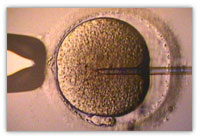Intracytoplasmic sperm injection


The Intracytoplasmic Sperm Injection, ICSI is a method of artificial insemination . Here, the sperm, the sperm of the man , directly into the cytoplasm (ooplasm) of an oocyte injected. A failure of fertilization can be almost ruled out.
ICSI is mostly used when previous in vitro fertilization attempts have been unsuccessful or the man has poor sperm quality. If there are no sperm in the ejaculate at all, it is possible to obtain them by means of microsurgical measures from testicular ( TESE ) or epididymal tissue ( MESA ) and use them for ICSI.
Morphological sperm selection
The intracytoplasmic injection of morphologically selected sperm (IMSI) is a further development of the ICSI. The sperm are analyzed at 6000 times magnification (ICSI = 400 times) and selected for injection into the egg cell . This method is specifically used for patients who have failed ICSI attempts.
discussion
The ICSI method is discussed on the basis of different points of view. The most common point of discussion is that direct interference with nature overrides the complex interrelationships and biological selection between sperm and egg cell (e.g. avoiding the development of embryos with hereditary diseases ). An increased rate of serious malformations has not yet been conclusively proven. However, study data indicate a connection between infertility treatment and the rate of congenital malformations, although it has so far remained unclear whether it is due to the treatment or the disorder itself. In recent years, for example, the first indications of an increased incidence of - comparatively rare - syndromes have appeared in the specialist literature , such as B. Beckwith-Wiedemann syndrome , Angelman syndrome , Prader-Willi syndrome . All of these syndromes are related to epigenetic phenomena such as imprinting or (unusual) DNA methylation of genes . In some cases, ICSI can lead to digynia , in which two maternal (maternal) chromosome sets are present in one zygote together with one paternal (paternal) chromosome set . The fetus then has type II triploidy .
It will be some time before a final assessment of this question is made because the syndromes are comparatively rare. These potential problems of ICSI, however, gain importance in the future, since practically before each pre-implantation diagnosis , this method is that is banned in the German-speaking countries currently apply to genetic tests using PCR or in situ hybridization to allow as Here the exact time of fertilization must be known in order to be able to adhere to the time window of the examination.
Currently, three ICSI attempts in Germany are half subsidized by the statutory health insurance funds (previously four to 100%). However, this only applies to married couples; unmarried couples have to bear 100% of the costs themselves (from approx. € 5,000 upwards per attempt). The ethics committee has made recommendations to adapt the Embryo Protection Act of 1990 to the new techniques. It is currently common practice to take several egg cells from women after hormone stimulation and fertilize them with the man's sperm. As currently, in contrast to other countries, in Germany no selection of the fertilized egg cells according to their development into an embryo is allowed, usually after only 3 days up to three embryos are inserted into the uterus, the rest of the fertilized egg cells are frozen for later experiments or discarded. The problem here is that after 3 days in most cases no so-called blastocyst has developed from which one hopes a better chance of implantation; this stage is only reached after approx. 5 days.
According to a press release from the European Society of Human Reproduction and Embryology (ESHRE) in July 2008, ICSI is used too often in Europe. For couples without pronounced male infertility, ICSI does not promise a better chance of pregnancy than in vitro fertilization (IVF). In addition, ICSI is more complicated and expensive. In Germany, the health insurance companies only have to bear the costs for artificial insemination using ICSI if certain defined limit values are met.
See also
- insemination
- Test tube baby
- Bioethics
- Intrauterine Insemination (IUI)
- Intracytoplasmic Injection of Morphologically Selected Sperm (IMSI)
Web links
- wunschkinder.net
- Microsurgical epididymal sperm aspiration (MESA) / testicular sperm extraction (TESE)
- Public petition from 2006 (in favor of health insurance funding)
- Explanations of the ICSI process. in the portal Familienplanung.de of the Federal Center for Health Education (BZgA)
- Explanations for understanding success rates. in the portal Familienplanung.de of the Federal Center for Health Education (BZgA)
Individual evidence
- ↑ J. Farhi, B. Fisch: Risk of major congenital malformations associated with infertility and its treatment by extent of iatrogenic intervention. In: Pediatric endocrinology reviews. 4 (4), 2007 Jun, pp. 352-357. PMID 17643083
- ↑ Cost of artificial insemination . Right magnifying glass, September 15, 2011; Retrieved September 15, 2011.
